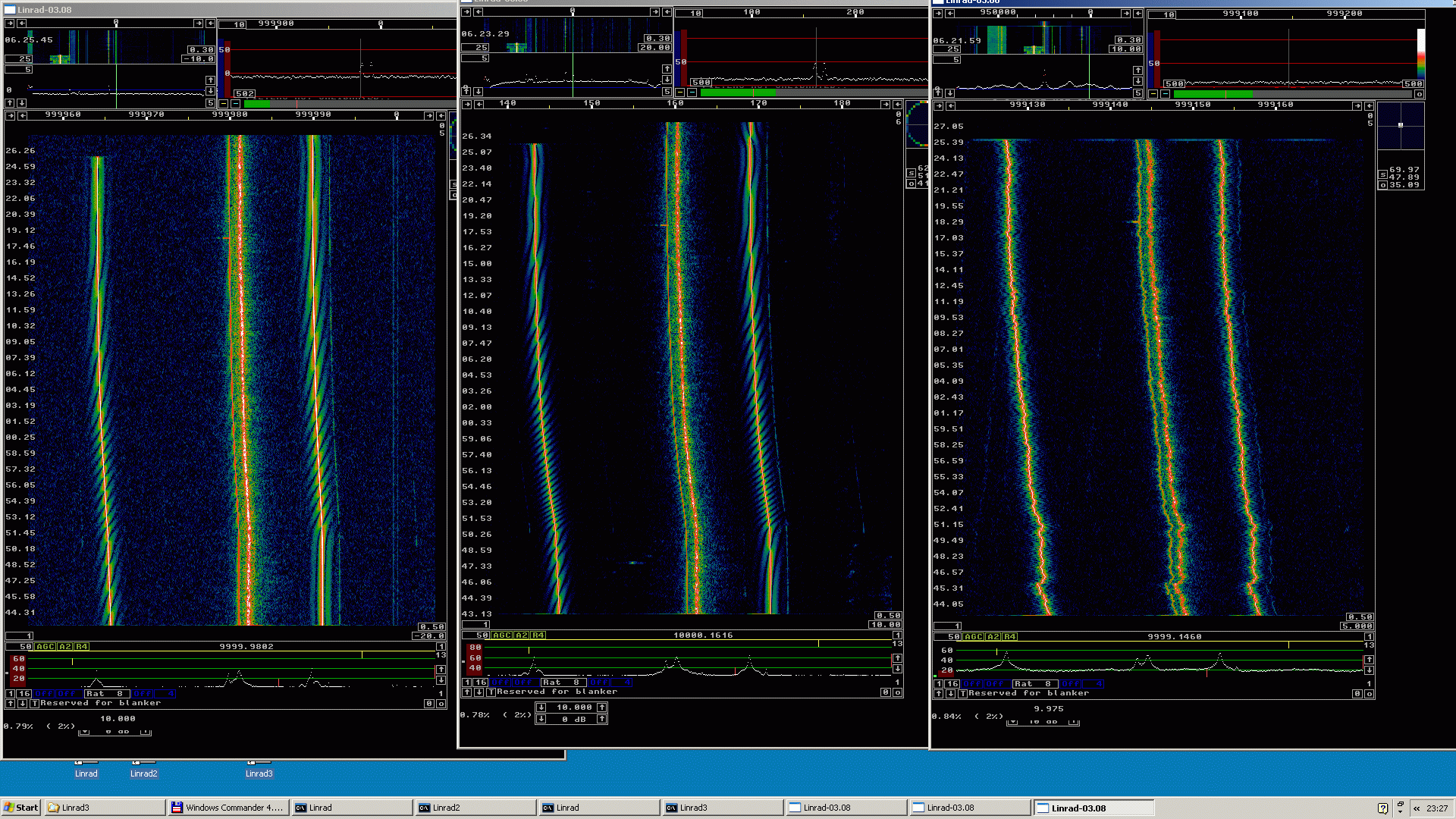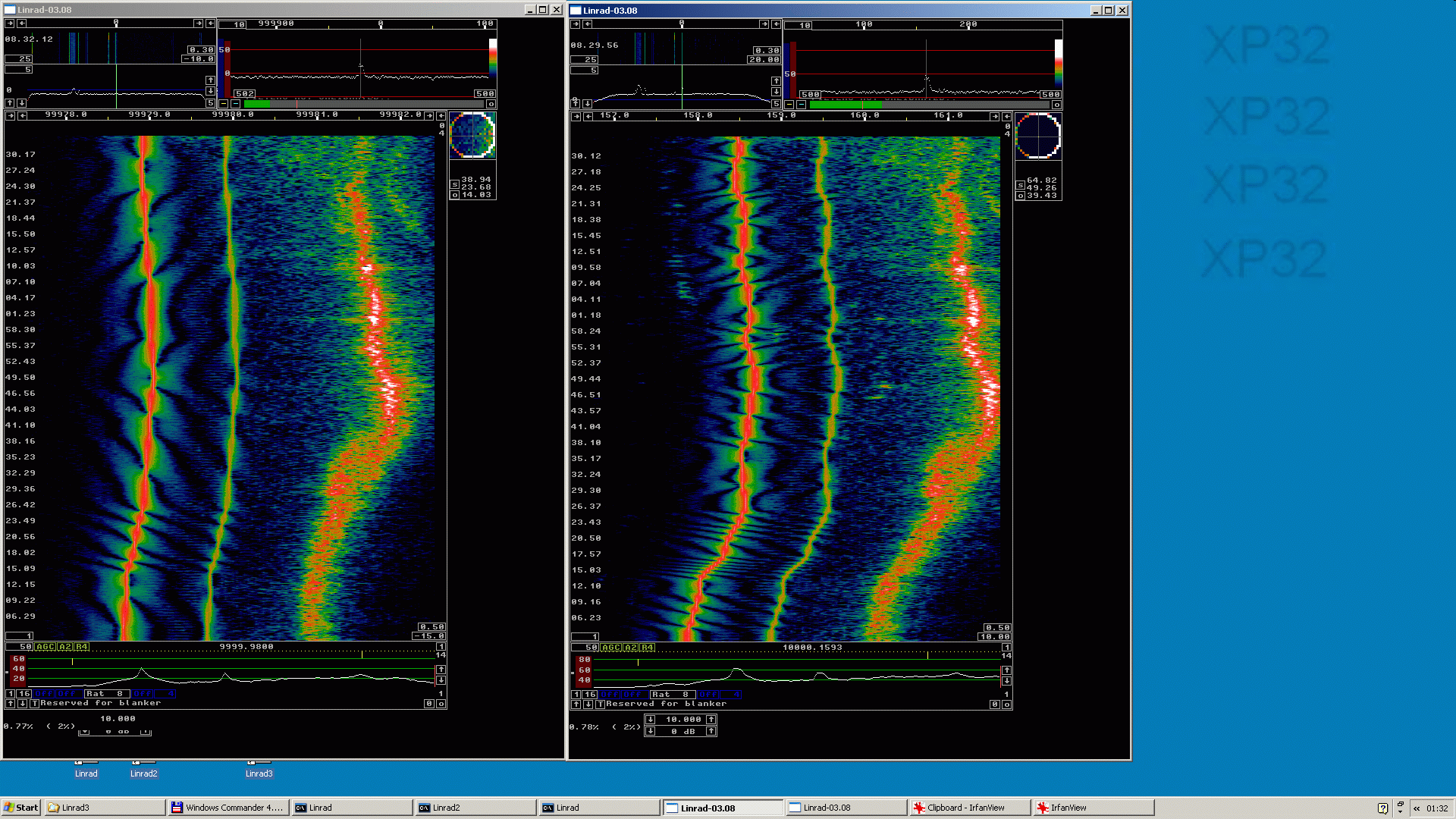
|
Some SDR software use a phase clock as a tool for precise frequency
adjustment.
In Linrad the corresponding tool is a high resoultion fft.
Rather than estimating the average phase and its rotation from
a phase clock the Linrad user can get the same information
(and much more) from a narrowband waterfall.
Figure 1 shows the screen with three instances of Linrad running in the same computer with three different hardware: Perseus, SDR-14 and WSE converters. |

|
|
Fig 1. Three different receivers monitoring 10 MHz simultaneously. From left to right: Perseus, SDR-14 and WSE converters. The total time span is about 45 minutes. There are four strong signals in figure 1. The one to the left, on the lowest frequency, is the 10 MHz local oscillator of the WSE RX2500 unit. It disappears when the WSE converters are switched off two minutes before the screen dump was made. The next rather weak signal is the local 10 MHz temperature stabilized reference that is used for all signal generators in the lab. About 1 Hz above it is a broad signal that comes from the antenna. Presumably it is WWV, Fort Collins, Colorado. The fourth strong signal is a HP 8657A signal generator which is set to 10.00001 MHz. It is exacly 10 Hz above the the local 10 MHz temperature stabilized reference to which it is locked. The four strong signals are far more frequency stable than any of the three receivers. The WSE converters have independent oscillators that first mix the signal up to 70 MHz and then back to zero. The frequency stability of the WSE converters should be sqrt(60*60+70*70)/10 times (=9 times) worse for the random components compared to the other units, while the temperature drift should be similar under the assumption that all oscillators have a similar temperature coefficient. Indeed that is what one can observe in figure 1. A more careful inspection shows that the first signal, the local oscillator of the RX2500 unit actually drifts a little compared to the other three signals. The Perseus is has a somewhat smaller temperature coefficient than the SDR-14. The window function used for figure 1 is flat with falloff using the the error function erfc(). It is the window 9 in the Linrad setup and it produces the sharpest lines in the waterfall. A side effect of the type 9 window is a response in several neighbouring frequency bins when the signal does not fall exactly on a bin. The shape of these side responses gives information that relates to the information that can be obtained from a phase indicator. Figure 2 makes this more obvious. |

|
|
Fig 2. Perseus (left) and SDR-14 (right) monitoring 10 MHz simultaneously. From left to right: Perseus, SDR-14 and WSE converters. The total time span is about 80 minutes. From figure 2 we see that the temperature coefficient of the SDR-14 is about 2.5 times larger than the temperature coefficient of the Perseus. The SDR-14 also has more random frequency fluctuations. The frequency scale of the waterfall is expanded and one can clearly see that nearly all the signal energy is presented in a single frequency bin at regular time intervals. Each time that happens a phase clock for the frequency of that particular frequency bin would show zero degrees. The times where the signal is present symmetrically in two frequency bins correspond to a phase clock that turns 180 degrees for the time interval of one transform. The three signals visible in figure 2 is from left to right a HP 8657B set to 9.999999 MHz (1 Hz below 10 MHz), the local 10 MHz reference to which the 8657B is locked and the WWV signal from a simple antenna. The frequency of the WWV signal is in the range 1.2 to 2.2 Hz above the local frequency standard. From figure 2 one might conclude that the local reference oscillator is too low by 1.5 Hz with an uncertainty of +/- 0.5 Hz. Figure 3 shows a measurement over a longer time. From about 15.30 to 21.20 local time on Sept 24 2009. Here the local frequency reference oscillator and the WWV signal are the only signals. From this graph onre might conclude that the local reference is too low by 1.1 Hz with an uncertainty of +/- 0.2 Hz. Maybe a better estimate could be made with some knowledge of ionosphere physics....... |

|
|
Fig 3. oscillator and WWV received with the Perseus HF receiver. To SM 5 BSZ Main Page |